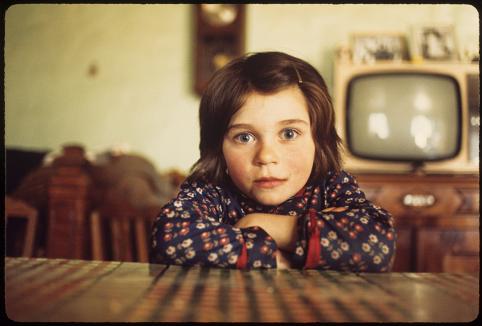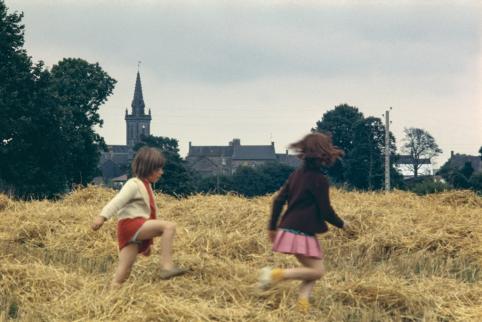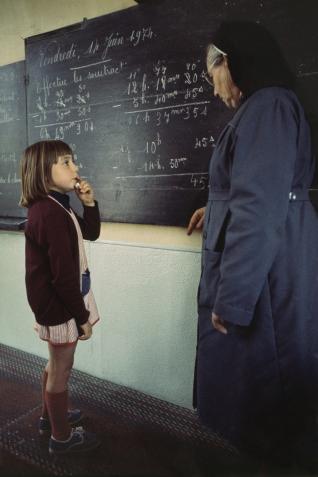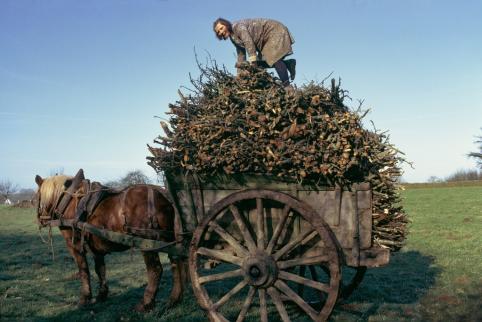Following on from the shows at the Gwinzegal Art Centre in Guingamp and the Musée de Bretagne in Rennes, the Musée Nicéphore Niépce presents “Madeleine de Sinéty, A Village”.
The show features 120 photographs that trace ten years of the photographer’s life and work, with an additional forty shots that were not part of previous iterations.
Madeleine de Sinéty’s work comes with a journal that is both factual and personal, and covers a wealth of iconographical categories that includes family photographs, portraits, reportage and ethnographical studies.
When photography was invented, people suddenly became visible as they were. According to the light they reflected, their imprint could now appear on a light-sensitive surface. This major anthropological event opened the way for the documentation and study of absolutely everything: monuments, landscapes, but also peoples. Ethnography took full advantage of this, but photography is, above all, a form of representation. People make themselves available and photography merely interprets; we can only presuppose the objectivity of the document, nothing more. This potential for truth in a photograph therefore requires a historical, social and cultural framework, in addition to inside knowledge of the mental structures that presided over their creation.
[1]
Madeleine de Sinéty’s work involves understanding how individuals relate to one another, tracking the traditions that tie them together and uncovering personal and collective stories. Regardless of their status, it is undeniable that these photographs tell us much about an era and a community. They provide an attentive account of a social reality: a rough life, still without electricity or running water, in some cases, and with few mechanical tools. A vision of the precariousness of an agricultural world that was on the way out. Contrary to the ethnologist who must always keep “one foot in and one foot out”, Madeleine de Sinéty did not keep her distance. On the contrary, she shared the lives of her subjects. She was fiercely attached to people, and her long-term commitment to her subjects was decidedly unscientific.
A close look at the photographs and an in-depth study of her writings tells us that her project is truly something else. It appears to be based on an inner need, detached from any form of functionality in terms of the pictures. Madeleine de Sinéty is looking for an “elsewhere”, an intimate elsewhere that signifies a break and a significant life change. Her background is aristocratic, and as a small child, she resented never being allowed to venture onto the farm attached to the family chateau: “I came to Poilley (…) completely by accident. I was living in Paris and knew nothing whatsoever about the countryside, even though I had spent most of my childhood summers in Valmer, my great-grandmother’s Renaissance chateau in the Loire valley. From my third-floor, attic-bedroom window, over the French-style gardens and the high stable walls, I could see a corner of the farmyard. I would spend hours watching the cows enter and leave the stables, listening to them moo, watching the farm children jump in the hay and the long-haired horses slowly pull the high-sided wooden trailers with big, iron-clad wheels. I could hear the shouts and the laughter, the wheels clattering on the farmyard cobbles, the high-pitched whistle of the thresher. I could smell all of the farm’s smells, the freshly-cut hay, the warm cow-pats, the fermenting milk, but I was not allowed to go. The farm was off limits to the children of the château.”
Years later, she got the urge to discover this elsewhere that seemed so close. She wanted to move to the country, discover another life, and to do so she would have to integrate, to truly take part in the everyday life of the community, over a long period.
“(…) I decided to stop for the night in the most remote village I could find. The following morning, I awoke to the sounds, shouts and smells of the farm of my childhood. I always travel with my bicycle in my car, so I took it out and went for a spin around the surrounding countryside. For the first time ever, there was no one to prevent me from entering the farm. I went back to Paris to resign from my job as an illustrator and set about organising my new life in Poilley.”
Things were not easy in the beginning. She took to wearing wooden clogs and was seen as eccentric. It was even said in the village that she was a spy! She had her moments of doubt, but her interest in life as it was lived in Poilley was genuine. She really got involved, working hard, making no concessions. She shared the everyday lives of a number of families as they worked the soil, planting, harvesting, calving, making hay, slaughtering pigs… taking part in farm life in every season. The locals got used to her presence and to her camera.
Her close relationships with her subjects can be seen in her photographs. She allows the villagers to come into the frame naturally, until they eventually become consenting players in the project. They end up trusting her to “see their own story”: “I began photographing Poilley in colour and every now and then I would invite the village to a slide show. We had to carry extra benches from the church to the dirt-floored village hall in order to seat everyone so that they could admire their own lives and work. Amid the shouts and laughter, they were surprised to find they were so beautiful.”
Madeleine de Sinéty photographed stories, big and small, and catalogued them all in her journal. Every evening she would write down everything she had heard during the more or less formal interviews, and would plan what she wished to photograph the following day. She gave equal importance to the banal and the extraordinary. She set down unforgettable quarrels between families, accounts of how to grow beetroot, a calculation of how many potatoes bought a pair of clogs, and unfailingly recorded the precision and indifference of movements that are repeated thousands of times to the rhythm of nature: a woman tossing hay, a man striding through a field, children playing in piles of apples… She experienced this world. She did not just build a visual representation, she added smells, noises, feelings… Looking at the pictures today, the emotion can still be felt. Through photography, today’s viewers can access a real sensory and emotional experience.
In the late sixties, French rural communities had been shoved into modern times and were having a hard time coping with this sea change, in particular the consolidation of land holdings. They were bewildered, stuck between peasant farmers and farm “operators”. Madeleine de Sinéty was only too aware of this development. She knew she was not recording the future of agriculture, as mechanisation and monoculture were soon to become the rule.
Over time, her photographs, in typical seventies slide colours, have taken on a new resonance. They bear witness to customs and a way of life that have disappeared, to a life of immense freedom and natural generosity, to a pace of living where speed was not an issue, to a time past where farm animals were known by their names, “Coquette”, “Bijou”… The before-times, that are of particular relevance to us today.
“The work is hard, but this house is so peaceful, I want to live here, rocked to sleep by the slow ticking of the clock in the hall. The work is hard, but regular. Day after day, we calmly dig, labour, prune and water to be rewarded with wheat and summer fruit.
Then it starts all over again, quietly, without haste, anxiety or fear, and each year feels like the one before, as if we could live forever.”
Madeleine de Sinéty.
The book :
Madeleine de Sinéty, Un village
Editions GwinZegal
23x21 cm
188 pages
ISBN : 979-10-94060-28-5
[1] André Rouillé « Le document ethnographique en question »








